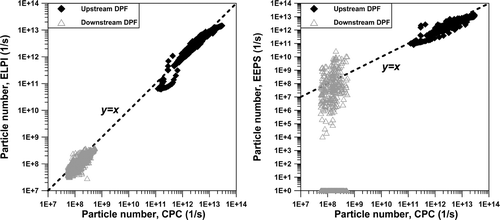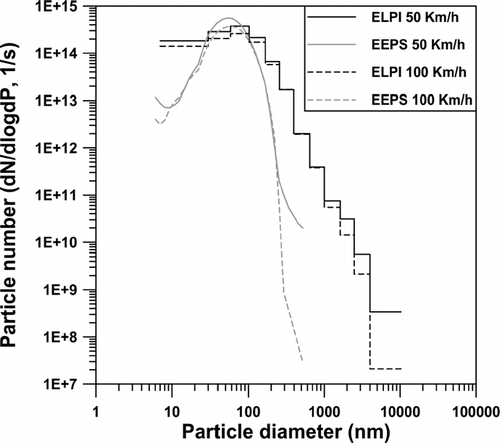An Engine Exhaust Particle Sizer (EEPS) Spectrometer, a Condensation Particle Counter (CPC) and an Electrical Low Pressure Impactor (ELPI) were used to determine the exhaust particle number of a Diesel engine on steady speeds and on the New European Driving Cycle (NEDC), upstream and downstream several Diesel Particulate Filters (DPF). In order to obtain different particle numbers, five DPFs with different porosity were used. The above three instruments give quite similar total particle numbers on steady speeds and on the NEDC for the tests upstream DPF. Downstream DPF, EEPS reaches its limit of measurement; however, the total particle numbers obtained by this instrument are still close to the particle numbers obtained by CPC and ELPI. The particle number versus time of the three instruments are quite close in the case of the NEDC measurements upstream DPF. Downstream DPF, CPC, and ELPI give quite similar signals, but EEPS reached its limits of detection. Upstream DPF, ELPI, and EEPS determine quite similar median diameters in the case of steady speeds, despite their different shape in particle size distribution.
INTRODUCTION
Current European regulations are based on a gravimetric method for the exhaust PM measurements; however, other techniques will probably be necessary in the future. The measurement of particle number instead of particulate mass is proposed for future regulations (CitationUNECE 2001).
Many methods can determine the exhaust particle number and/or size determination. The most common used in the case of vehicle exhaust gas are the Electrical Low Pressure Impactor (CitationELPI, Keskinen et al. 1992; CitationKhalek 2000; CitationMaricq et al. 2000; CitationWitze et al. 2004; CitationZervas et al. 2004; CitationZervas et al. 2005), Scanning Mobility Particle Sizer (CitationSMPS, Wang and Flagan 1990) and Particle Counters (CitationWilleke and Baron 1993; CitationHinds 1999; CitationPui and Chen 2001), but many others are also reported in literature. CitationBurtscher (2005) and CitationMohr et al. (2005) give a detailed description of several analytical methods.
Each of these methods has some advantages but also some disadvantages: SMPS has a very good particle size resolution; however, it has an insufficient resolution time. For this last reason, this technique cannot be used for transient particle measurement on the NEDC. ELPI has a sufficient time resolution (one second) for NEDC measurements, but its size resolution is lower than the size resolution of SMPS. Condensation Particle Counter (CPC) can be used in the case of total particle number measurements on steady speeds and on cycles, but this last method cannot determine the size distribution of exhaust particles.
Engine Exhaust Particle Sizer (EEPS) Spectrometer is a quite new instrument developed for exhaust particle measurements (CitationTSI 2004; CitationJohnson et al. 2004; CitationLiu et al. 2005). It can be used in transient cycles and can determine quite well the particle distribution. The EEPS spectrometer permits a given size range to be scanned in one tenth of a second increments and a response time of about 1 second. Although the size resolution of the EEPS is lower than that of the SMPS (16 versus 64 channels per decade), its high sampling rate allows instantaneous measurement of engine emissions. The EEPS determines particles between 6 nm and 560 nm, which include the majority of emitted Diesel exhaust particles. A detailed description of EEPS operation can be found in the operation manual (CitationTSI 2004). A brief description is presented here: EEPS classifies particles based on their differential electrical mobility. Particles pass through a charger and then join a particle-free sheath air. A particle-laden flow enters into the column, which contains an axial high-voltage central rod with 22 electrode rings forming the outer wall. The charged particles are deflected radially outward, separated by their differential electrical mobility, and then collected on the electrically isolated electrode rings. The particle number concentration is then determined by the electrical current measured on each electrode ring.
Two inter-laboratory exercises were conducted in order to determine the performances of the other two instruments used in this work: ELPI (CitationZervas et al. 2005) and CPC (CitationZervas et al. 2006). In the current work, the performances of EEPS is tested and compared with the performances of ELPI and CPC. A Diesel engine, operating on steady speeds and on NEDC, is used for this study. The measurements were conducted upstream and downstream DPFs. Several particulate filters with different porosity were used in this study in order to obtain different particle numbers downstream DPF.
EXPERIMENTAL SECTION
Engine and Experimental Conditions
A 2.2L, direct injection, common rail Diesel engine was used for this work. The post-treatment line consisted of a Diesel Oxidation Catalyst (DOC, 0.5L) and a catalytic Diesel Particulate Filter (2.5L). This engine is tested on a dynamic engine test bench at two steady speeds of 50 and 100 km/h (after temperature stabilization), and on the NEDC (cold start, simulating a vehicle of 1814 kg inertia). In order to obtain different particle numbers on the exhaust gas, four catalytic (commercial and under development) DPFs with different porosity were used. These filters are named B-E as a function of decreasing porosity. To simulate a filter with even higher porosity, some channels of the filter E were opened (filter A). Exhaust particle numbers were measured on raw gas, upstream and downstream DPF. Two fuels were used in this work: with 300 and 10 ppm of sulfur. The particle number of the dilution tunnel air (blanks) were measured during 20 minutes before and after each test. These values were not subtracted from the particle number of vehicles measurements. The particle numbers of the tunnel background tests are expressed in 1/km using the same CVS volume and distance as a NEDC test.
Analytical Methods Used
A Fine Particle Sampler (FPS) from DEKATI was used to dilute the raw exhaust gas (×15, with N2 at 150°C), followed by a PALLAS secondary diluter (×10, with N2 at 20°C). Then the diluted sample was split into three parts using a TSI flow splitter. This accessory is especially useful when performing instrument comparison. Exhaust particle numbers were measured by three instruments: a DEKATI ELPI (measuring particle cut sizes 7 nm to 10 μ m, more details about this instrument can be found in CitationZervas et al. 2005), a TSI CPC Model 3022A (measuring particles bigger than 7 nm) and a TSI EEPS (measuring particle cut sizes from 6 nm to 560 nm). In order to compare the three instruments, total particle numbers are expressed in 1/km, taking into account all stages of the ELPI and EEPS, but also taking into account only particle diameters greater than 30 nm in the case of the last two instruments (not taking into account the stages/channels of ELPI/EEPS measuring particles with lower diameters).
RESULTS AND DISCUSSION
Total Particle Number Measured by the Three Instruments
The total particle number upstream DPF is quite similar at 50 and 100 km/h and on the NEDC: 1.5 − 6.6 × 1014 1/km, 8.2 × 1013 − 5.8 × 1014 1/km and 1.4 − 7.5 × 1014 1/km, respectively (). These numbers are quite similar to the numbers already reported in the literature (CitationHall et al. 1998; ACEA 2002; CitationZervas et al. 2004; CitationZervas et al. 2005). On average, CPC gives slightly higher values than ELPI and EEPS. The higher values of CPC comparing to ELPI are also observed in ACEA 2002 for the speed of 120 km/h, while the same report shows the opposite trend at the speed of 50 km/h and CitationJohnson et al. (2004) observed that EEPS gives higher particle numbers than CPC, but only in the case of low engine loads. However, the above differences are not very significant, because there are generally found within the repeatability limits reported in the two inter-laboratory studies of ELPI and CPC (CitationZervas et al. 2005; CitationZervas et al. 2006). The ELPI > 30 nm and EEPS > 30 nm give respectively 15–57% and 1–28% lower particle numbers than when all stages/channels are taken into account.
TABLE 1 Particle numbers at 50 km/h, 100 km/h and on the NEDC, upstream and downstream DPFs and blank measurements for the different DPF used. The S content of the fuel is in brackets beside the DPF name. The ELPI, CPC, and EEPS LOD values are 5.3E+10, 2E+07, and 6E+10 1/km, respectively, while the corresponding LOQ values are 1.5E+11, 6E+07, and1.8E+11 1/km
The downstream DPF particle numbers are 3–4 orders of magnitude lower than the corresponding upstream ones. As in the case of upstream DPF measurements, the total particle number downstream DPF is similar for the 50 and 100 km/h and on the NEDC: 1.3 × 109 − 9.3 × 1011 1/km, 4.5 × 109 − 9.3 × 1011 1/km, and 1.9 × 109 − 8.7 × 1011 1/km, respectively (ACEA 2002; CitationZervas et al. 2004; CitationZervas et al. 2005), depending on DPF porosities. Generally, the particle number increases at lower DPF porosities. In the case of DPFs with low porosity, the three instruments determine quite different particle numbers, very close to the particle numbers measured for ambient air background tests (1.9 × 108 − 2.0 × 1011 1/km, quite similar values are also reported in CitationZervas et al. (2004) and CitationZervas et al. 2005). Downstream DPF, ELPI > 30 nm, and EEPS > 30 nm give lower particle numbers than ELPI (0–96%), and EEPS (14–99%).
compares, for all experiments performed, the total particle number determined by the three instruments. Left figure shows the particle number determined by ELPI, ELPI > 30 nm, EEPS and EEPS, > 30 nm versus the particle number determined by CPC, while the middle and right figures the total particle number of all instruments versus the total particle number determined respectively by ELPI and EEPS. The best fit y = ax+b line is determined for each couple of instruments and plotted in these figures. The upper-right block of points corresponds to the experiments upstream DPF. These points are on or very close to the line y = x, indicating that for the particle numbers higher than 1 1014 1/km, the results of the three instruments are very similar. In the case of lower particle numbers, corresponded to the blanks and downstream DPF experiments, a quite important data scattering can be observed, indicating that, for downstream DPF tests, the total particle number is difficult to be determined and the three instruments cannot be well correlated.
FIG. 1 Comparison between total particle numbers determined by CPC, ELPI, ELPI > 30 nm, EEPS, and EEPS > 30 nm. (a) CPC basis; (b) ELPI basis; (c) EEPS basis.
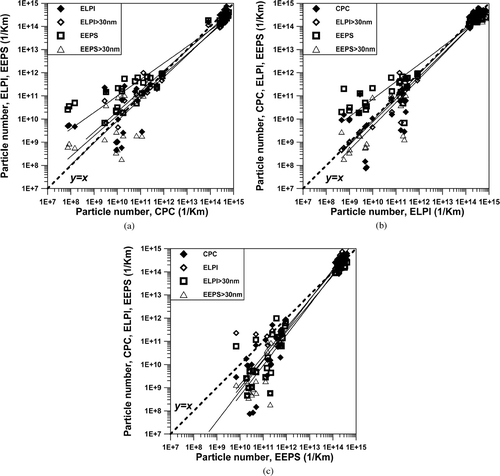
A particular correlation must be noted. In the middle graphic, the ELPI > 30 nm points corresponded to very low particle numbers (blank experiments and DPFs with very low porosity) are not very scattered and very close to the y = x line, indicating that for the tests downstream DPF the first ELPI stage contains very low particle numbers.
Particle Number versus Time Measured by the Three Instruments on the NEDC
Upstream DPF and on NEDC experiments, the three instruments measure similar particle numbers versus time (). These curves follow quite well the cycle. The order CPC > ELPI > EEPS is generally observed, with higher difference during the extra-urban driving cycle (EUDC). However, these differences are generally within the repeatability limits of these instruments (CitationZervas et al. 2005; CitationZervas et al. 2006).
FIG. 2 Particle number versus time measured by CPC, ELPI, and EEPS. Average value for all tests upstream and downstream DPF on NEDC.
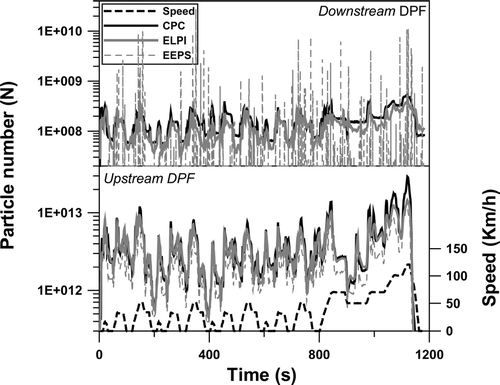
Downstream DPF, only CPC and ELPI can give usable data versus time on NEDC. The particle numbers versus time of these two instruments follow quite well the cycle. As in the case of upstream DPF, the order CPC > ELPI is generally observed, especially during the EUDC, but this difference is once more within the repeatability limits. Contrary to the other two instruments, EEPS signal goes down to zero most of the time. The probable reason is that the particle number downstream DPF is lower than the detection limits of this device, indicating that a lower dilution ratio must be used for downstream DPF measurements using EEPS. Nevertheless, it must be noted that the total particle number determined by EEPS is quite similar to the particle number determined by the other two instruments.
Taking all data obtained on NEDC versus time, there is a quite good agreement between CPC, ELPI, and EEPS for the measurements performed upstream DPF (). ELPI versus CPC data are very often on the y = x line, except the very low numbers corresponding to idle emissions and the very high particle numbers, where ELPI generally gives lower values than CPC. EEPS versus CPC data are generally on or slightly below the y = x line, with slightly higher dispersion than the ELPI versus CPC data. In the case of downstream DPF experiments, there is a high data scattering. Even with high dispersion, ELPI versus CPC data are found around the y = x line. This is not the case of EEPS versus CPC data, which are very often far from the y = x line. The downstream DPF EEPS/CPC data are more scattered than the ELPI/CPC ones.
Median Particle Diameter and Particle Size Distribution of ELPI and EEPS
In the case of steady speeds and upstream DPF measurements, EEPS determine slightly higher median diameter than ELPI (). The average median diameter determined by ELPI is 52 nm and 48 nm, respectively, for the 50 km/h and 100 km/h, while the corresponding EEPS values are 59 nm and 60 nm. ACEA 1999 and 2002 also reports no significant difference of median diameter between 50 and 100 km/h. Moreover, the values measured in our study are within the repeatability limits: the 1.96*RSD values of ELPI median diameter are 37% and 57%, respectively, for the 50 km/h and 100 km/h, while the corresponding values of EEPS are 19% and 31%. For this reason, the median diameter determined by the two instruments can be considered as similar. EEPS has a better repeatability for this type of measurements than ELPI, due to the narrow cut size of each channel (16 channels per decade). The EEPS median diameter cannot be determined downstream DPF, because this instrument reached its lower detection limits in these measurements.
FIG. 4 Median particle diameter determined by ELPI and EEPS in the case of steady speeds and upstream DPF measurements. M: average value. The three bars of the M bars correspond to the min, average, and max values. Min and max values determined as: min = average value − 1.96*standard deviation, max = average value + 1.96*standard deviation.
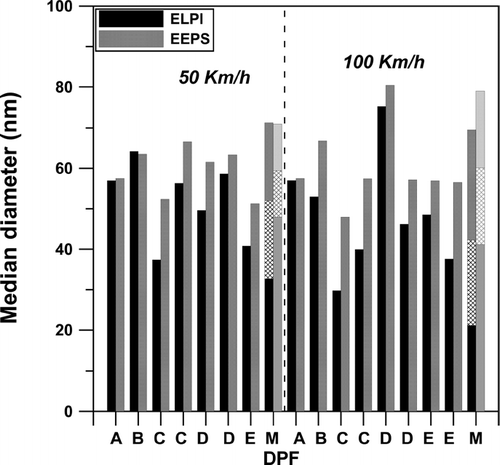
shows the average particle distribution of ELPI and EEPS for the steady speeds of 50 and 100 km/h in the case of upstream DPF measurements. For both instruments, the maximum number is determined at the same particle size. However, EEPS has a higher size resolution and gives a more “bell-type” distribution than ELPI. It must be noted that the median diameter cannot be precisely determined by ELPI due to the quite large cut size of this instrument.
Comparison of ELPI and EEPS Results using All Stages/Channels or only the > 30 nm Ones
The percentage of ELPI > 30 nm and EEPS > 30 nm comparing to ELPI and EEPS is presented in for all experimental points. Upstream DPF, the average ELPI > 30 nm percentage using all experimental points (steady speeds and NEDC tests) is 65% while the EEPS > 30 nm average percentage is 93%. The upstream points are quite repeatable, as the relative standard deviation (RSD) of these points are 14% in the case of ELPI and 7% in the case of EEPS. These percentages indicate that ELPI measures much more very small particles than EEPS.
FIG. 6 Percentage of ELPI > 30 nm and EEPS > 30 nm comparing to ELPI and EEPS for the steady speeds of 50 and 100 km/h and NEDC tests for the different DPFs used. Experiments upstream and downstream DPF; BA: blank air experiments.
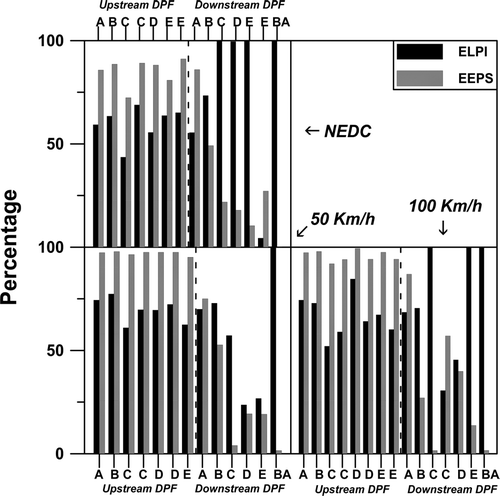
Downstream DPF, the average percentage ELPI > 30 nm is the same as in the case of upstream DPF (65%). However, a very important data scattering can be observed: the RSD is 47% in this last case. No particles are measured in the ELPI stage with cut diameter < 30 nm in the case of several points of the NEDC tests, leading to an ELPI > 30 nm percentage of 100%. This percentage is very low (reaching only 4% in one case) in the case of other experimental points, as almost all particles measured are found in the stage with cut diameter < 30 nm. This phenomenon is due to the very low particle numbers measured, indicating that ELPI is not the most adequate technique for particle number measurements downstream DPF. It must be noted than ELPI repeatability is very poor at low particle numbers (CitationZervas et al. 2004; CitationZervas et al. 2005).
The average EEPS > 30 nm percentage is much lower downstream than upstream DPF: only 35% against 92%. However, the RSD is much higher than upstream DPF: 77% against 7% upstream DPF. shows that, contrary to ELPI, EEPS always determine some very fine particles, as the EEPS > 30 percentage is never 100%.
shows that, for blank measurements, the percentage of ELPI > 30 nm is always 100%, because the particle number of the ELPI stage with cut diametr < 30 nm is null. However, there is a disagreement with the EEPS > 30 nm, as the EEPS > 30 nm percentage is very low, 0–1.5%, because almost all particles measured by this instrument in the case of blank measurements are found to be less than 30 nm.
CONCLUSIONS
CPC, ELPI, and EEPS were used for the exhaust particle number determination of a Diesel engine. Upstream and downstream DPF, there is a quite good agreement for the total particle number of steady speeds and NEDC determined by the three instruments; however, the order CPC > ELPI > EEPS is generally observed, but this difference is generally within the repeatability limits. Downstream DPF, the particle number generally increases with DPF porosity. Nevertheless, an important data scattering downstream DPF and blank measurements have been observed due to the low level of particle numbers obtained. In the case of NEDC measurements and upstream DPF, the particle numbers versus time determined by the three instruments are quite close to each other and follow quite well the cycle. Downstream DPF, CPC, and ELPI give quite similar results, but EEPS signal is generally below its limit of detection. Upstream DPF, ELPI, and EEPS give quite similar median diameters, although their difference in the shape of the size distribution.
REFERENCES
- December 1999 . “ ACEA programme on emissions of fine particles from passenger cars. Report ” . December , www.acea.be
- Burtscher , H. 2005 . Physical Characterization of Particulate Emissions from Diesel Engines: A Review . J. Aerosol Sci. , 36 : 896 – 932 . [CSA]
- Hall , D. E. , Goodfellow , C. L. , Heinze , P. , Rickeard , D. J. , Nancekievill , G. , Martini , G. , Hevesi , J. , Rantanen , L. , Merino , P. M. , Morgan , T. B. D. and Zemroch , P. J. 1998 . “ A Study of the Size, Number and Mass Distribution of the Automotive Particulate Emissions for European Light-Duty Vehicles ” . SAE Technical Paper Series 982600
- Hinds , W. C. 1999 . Aerosol Technology , New York : J. Wiley & Sons .
- Johnson , T. , Caldow , R. , Pöcher , A. , Mirme , A. and Kittelson , D. 2004 . A New Electrical Mobility Particle Size Spectrometer for Engine Exhaust Particle Measurements , SAE Technical Paper Series 2004-01-1341
- Keskinen , J. , Pietarinen , K. and Lehtimaki , M. 1992 . Electrical Low Pressure Impactor . J. Aerosol Sci. , 23 : 353 – 360 . [CROSSREF] [CSA]
- Khalek , I. A. 2000 . Characterization of Particle Size Distribution of a Heavy-Duty Diesel engine during FTP Transient Cycle Using ELPI , SAE Technical Paper Series 2000-01-2001
- Liu , Z. G. , Thrurow , E. M. , Caldow , R. and Johnson , T. R. 2005 . Transient Performance of Diesel Particulate Filters as Measured by an Engine Exhaust Particle Size Spectrometer , SAE Technical Paper Series 2005-01-0185
- Maricq , M. M. , Podsiadlik , D. H. and Chase , R. E. 2000 . Size Distributions of Motor Vehicle Exhaust PM: A Comparison Between ELPI and SMPS Measurements . Aerosol Sci. Technol. , 33 : 239 – 260 . [CROSSREF] [CSA]
- Mohr , M. , Lehman , U. and Rutter , J. 2005 . Comparison of Mass-Based and Non-Mass Based Particle Measurement Systems for Ultra-Low Emissions From Automotive Sources . Environ. Sci. Technol. , 39 : 2229 – 2238 . [INFOTRIEVE] [CROSSREF] [CSA]
- Pui , D. Y. H. and Chen , D. 2001 . “ Direct-Reading Instruments for Analyzing Airborne Particles ” . In Air Sampling Instruments , 377 – 414 . Cincinnati, OH : ACGIH . Chapter 15
- TSI . 2004 . Model 3090 Engine Exhaust Particle Sizer Spectrometer, Operation and service manual, TSI Incorporated, MN, USA, 2004
- UNECE . 2001 . GRPE Particle Measurement Programme , Programme overview http://www.unece.org/trans/main/wp29/wp29wgs/wp29grpe/infpapers_42.html
- Wang , S. C. and Flagan , R. C. 1990 . Scanning Electrical Mobility Spectrometer . Aerosol Sci. Technol. , 13 : 230 – 240 . [CSA]
- Willeke , K. and Baron , P. A. 1993 . Aerosol Measurement, Principles, Techniques and Applications , New York : Van Nostrand Reinhold .
- Witze , P. O. , Chase , R. E. , Maricq , M. M. , Podsiadlik , D. H. and Xu , N. 2004 . “ Time-Resolved Merasurement of Exhaust PM for FTP-75: Comparison of LII, ELPI and TEOM Techniques ” . SAE Technical Paper Series 2004-01-0964
- Zervas , E. , Dorlhène , P. , Daviau , R. and Dionnet , B. 2004 . Repeatability of Fine Particle Measurement on Diesel and Gasoline Exhaust Gas , SAE Technical Paper Series 2004-01-1983
- Zervas , E. , Dorlhène , P. , Forti , L. , Perrin , C. , Momique , J. C. , Monier , R. , Ing , H. and Lopez , B. 2005 . Inter-Laboratory Test of Exhaust PM Using ELPI . Aerosol Science and Technology , 39 : 333 – 346 . [CSA]
- Zervas , E. , Dorlhène , P. , Momique , J. C. , Monier , R. , Forti , L. , Pasquereau , M. , Ing , H. and Lopez , B. 2006 . Inter-Laboratory Test of Exhaust Particle Number Measurement Using CPC . Energy and Fuels , [CSA]
